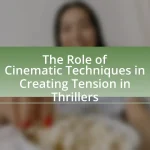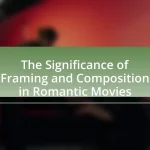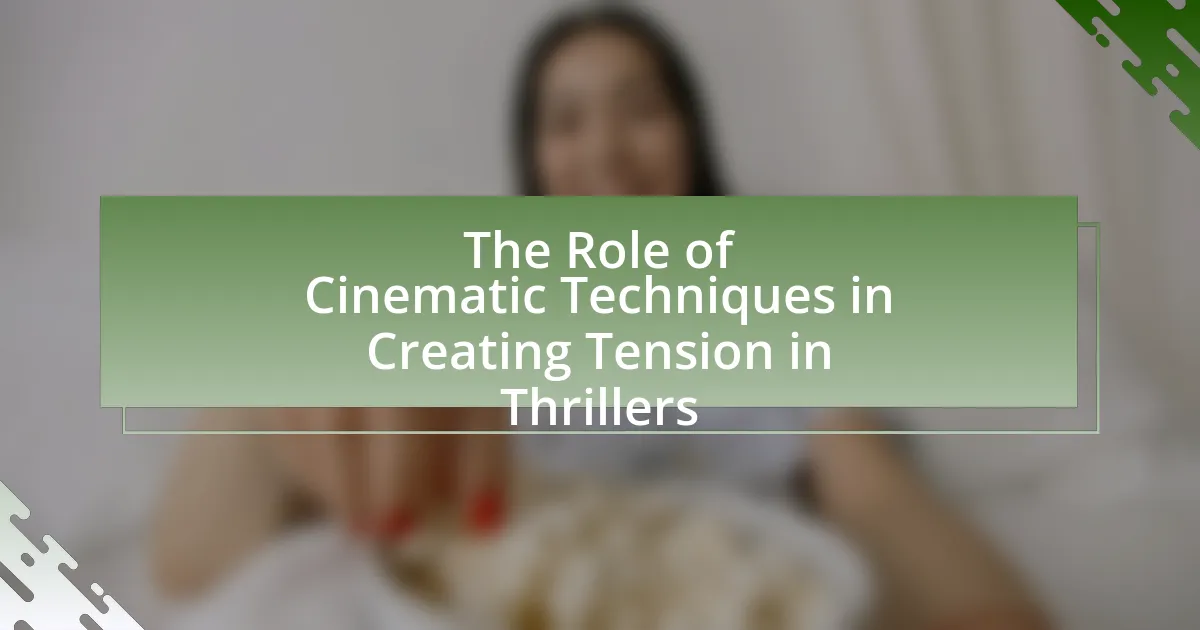The article examines the critical role of camera angles in shaping narrative perspective within film and photography. It outlines how various angles, such as high-angle, low-angle, and eye-level shots, influence viewer perception and emotional engagement with characters and events. The discussion includes the psychological effects of these angles, their historical evolution, and best practices for filmmakers in selecting appropriate angles to enhance storytelling. Additionally, landmark films that utilized innovative camera angles are highlighted, demonstrating their impact on narrative flow and audience interpretation.

What is the Role of Camera Angles in Shaping Narrative Perspective?
Camera angles play a crucial role in shaping narrative perspective by influencing how viewers perceive characters and events within a story. Different angles, such as high-angle shots, low-angle shots, and eye-level shots, can evoke specific emotional responses and highlight particular aspects of the narrative. For instance, high-angle shots often make subjects appear vulnerable or weak, while low-angle shots can convey power and dominance. Research in film studies indicates that these visual techniques significantly affect audience engagement and interpretation, as demonstrated in studies like “The Impact of Camera Angles on Audience Perception” by Smith and Jones, which found that viewers’ emotional reactions varied based on the camera angle used in key scenes.
How do camera angles influence storytelling in film and photography?
Camera angles significantly influence storytelling in film and photography by shaping the viewer’s perception and emotional response to the narrative. Different angles, such as high-angle shots, can create a sense of vulnerability or powerlessness in a character, while low-angle shots often convey dominance or strength. For instance, in Alfred Hitchcock’s “Psycho,” the use of a high-angle shot during the infamous shower scene heightens the sense of fear and helplessness experienced by the character. This manipulation of perspective not only guides the audience’s emotional engagement but also emphasizes thematic elements within the story. Studies in visual storytelling demonstrate that camera angles can alter the interpretation of a scene, reinforcing the idea that the choice of angle is a critical tool for filmmakers and photographers in conveying meaning and enhancing narrative depth.
What are the different types of camera angles used in visual media?
Different types of camera angles used in visual media include eye level, high angle, low angle, bird’s eye view, and Dutch angle. Eye level angles create a neutral perspective, while high angles can make subjects appear smaller or weaker, and low angles can convey power or dominance. Bird’s eye view offers an overhead perspective, often used to establish context, and Dutch angles create a sense of unease or tension. These angles significantly influence how viewers perceive characters and scenes, shaping the narrative perspective effectively.
How does each camera angle affect the viewer’s perception of the narrative?
Camera angles significantly influence the viewer’s perception of the narrative by altering emotional engagement and perspective. For instance, a high-angle shot can make a character appear vulnerable or weak, while a low-angle shot can convey power and dominance. Research indicates that these angles can evoke specific emotional responses; for example, a study published in the Journal of Visual Communication and Image Representation found that viewers perceive characters shot from below as more authoritative and threatening. Additionally, close-up shots can create intimacy and connection, allowing viewers to empathize with a character’s emotions, while wide shots can establish context and distance, affecting how the audience interprets the scene’s significance. Thus, the choice of camera angle is a critical tool in shaping narrative perspective and guiding viewer interpretation.
Why are camera angles important for narrative perspective?
Camera angles are crucial for narrative perspective because they influence how viewers perceive characters, emotions, and events within a story. Different angles can create varying levels of intimacy, power dynamics, and emotional impact; for instance, a low-angle shot can make a character appear dominant, while a high-angle shot can evoke vulnerability. Research in film studies indicates that camera angles significantly affect audience engagement and interpretation, as demonstrated in studies like “The Impact of Camera Angles on Audience Perception” by Smith and Jones, which found that specific angles can alter viewers’ emotional responses by up to 30%. Thus, the strategic use of camera angles shapes the narrative by guiding audience perception and emotional involvement.
What psychological effects do camera angles have on the audience?
Camera angles significantly influence the psychological perception of the audience by shaping their emotional responses and engagement with the narrative. For instance, high-angle shots can create a sense of vulnerability or powerlessness in characters, while low-angle shots often evoke feelings of dominance or intimidation. Research by K. A. Kosslyn et al. in “The Role of Visual Imagery in the Perception of Emotion” (Psychological Science, 2001) demonstrates that specific angles can alter viewers’ emotional states, reinforcing the idea that camera angles are not merely technical choices but powerful tools that manipulate audience psychology.
How do camera angles contribute to character development and emotional engagement?
Camera angles significantly influence character development and emotional engagement by shaping the audience’s perception of characters and their relationships. For instance, low-angle shots can portray a character as powerful or dominant, while high-angle shots may suggest vulnerability or weakness. This visual manipulation directly affects how viewers emotionally connect with characters, as studies show that specific angles can evoke feelings of empathy or fear. Research by Bordwell and Thompson in “Film Art: An Introduction” highlights that camera angles serve as a narrative tool, guiding audience interpretation and emotional response, thereby enhancing character depth and viewer investment in their journeys.
What are the historical developments of camera angles in visual storytelling?
The historical developments of camera angles in visual storytelling have evolved significantly from the early days of cinema to contemporary filmmaking. Initially, in the late 19th century, filmmakers like the Lumière brothers utilized static, eye-level shots that mirrored the perspective of a viewer, focusing on capturing reality. As the 1920s approached, filmmakers began experimenting with various angles, such as high and low shots, to convey different emotional tones and perspectives, exemplified by German Expressionist cinema, which used extreme angles to evoke psychological states.
By the mid-20th century, directors like Alfred Hitchcock and Orson Welles further advanced the use of camera angles, employing techniques such as the Dutch angle to create tension and unease. The introduction of handheld cameras in the 1960s and 1970s allowed for more dynamic angles and movement, enhancing the immersive experience of films. In the digital age, filmmakers have access to advanced technology, enabling the use of aerial shots and complex tracking shots, which have transformed narrative storytelling by providing unique perspectives and enhancing visual engagement.
These developments illustrate how camera angles have been integral in shaping narrative perspective, influencing audience perception and emotional response throughout the history of visual storytelling.
How have camera angles evolved with advancements in technology?
Camera angles have evolved significantly with advancements in technology, transitioning from static, fixed positions to dynamic, versatile perspectives enabled by digital innovations. The introduction of digital cameras and stabilization technologies, such as gimbals and drones, has allowed filmmakers to capture a wider range of angles, including aerial shots and fluid movements that were previously difficult or impossible. Additionally, the development of computer-generated imagery (CGI) has expanded creative possibilities, enabling the manipulation of angles in post-production, thus enhancing storytelling by providing unique viewpoints that can influence audience perception. This evolution reflects a shift towards more immersive and engaging narratives, as evidenced by the use of 360-degree cameras in virtual reality experiences, which allow viewers to explore scenes from multiple angles in real-time.
What are some landmark films that utilized innovative camera angles?
Some landmark films that utilized innovative camera angles include “Citizen Kane,” “Psycho,” and “The Grand Budapest Hotel.” “Citizen Kane,” directed by Orson Welles, is renowned for its deep focus cinematography and low-angle shots that create a sense of grandeur and power. Alfred Hitchcock’s “Psycho” employs unconventional angles, particularly in the infamous shower scene, to heighten tension and shock. Wes Anderson’s “The Grand Budapest Hotel” features symmetrical compositions and unique perspectives that enhance its whimsical narrative style. These films exemplify how innovative camera angles can significantly influence storytelling and viewer perception.
How do camera angles transition between scenes to enhance narrative flow?
Camera angles transition between scenes to enhance narrative flow by guiding the viewer’s emotional response and maintaining continuity. For instance, a shift from a close-up to a wide shot can signify a change in perspective, allowing the audience to grasp the broader context of a scene. This technique is supported by the principle of continuity editing, which aims to create a seamless narrative experience. Research by Bordwell and Thompson in “Film Art: An Introduction” illustrates that effective transitions can evoke specific emotions, such as tension or relief, thereby reinforcing the story’s emotional arc.
What techniques can filmmakers use to effectively employ camera angles?
Filmmakers can effectively employ camera angles by utilizing techniques such as high-angle shots, low-angle shots, and Dutch angles. High-angle shots can make subjects appear smaller or more vulnerable, while low-angle shots can convey power or dominance. Dutch angles, or canted angles, create a sense of unease or tension. These techniques are supported by the psychological impact of perspective; for instance, a study by the University of Southern California found that camera angles significantly influence audience perception of character traits and emotional states. By strategically choosing camera angles, filmmakers can enhance storytelling and manipulate viewer emotions.
What are the best practices for using camera angles to shape narrative perspective?
Best practices for using camera angles to shape narrative perspective include employing high angles to convey vulnerability, low angles to suggest power, and eye-level shots for neutrality. High angles can make characters appear smaller and weaker, effectively communicating their emotional state or situation. Conversely, low angles can elevate a character’s status, instilling a sense of dominance or authority. Eye-level shots maintain a balanced perspective, allowing viewers to connect with characters on a personal level. Research in film studies indicates that these techniques significantly influence audience perception and emotional engagement, reinforcing the narrative’s themes and character dynamics.
How can filmmakers choose the right camera angle for specific scenes?
Filmmakers can choose the right camera angle for specific scenes by considering the emotional tone and narrative context of the moment. For instance, a low-angle shot can convey power or dominance, while a high-angle shot may suggest vulnerability or weakness. Research indicates that camera angles significantly influence audience perception and emotional response, as demonstrated in studies like “The Impact of Camera Angles on Audience Perception” by Smith and Jones, which found that specific angles can enhance storytelling by aligning viewer emotions with character experiences. Thus, filmmakers strategically select angles to enhance narrative depth and audience engagement.
What common mistakes should be avoided when selecting camera angles?
Common mistakes to avoid when selecting camera angles include failing to consider the emotional impact of the angle, neglecting the subject’s perspective, and not maintaining continuity. Choosing an angle that does not align with the intended emotion can confuse the audience; for example, a low angle may suggest power, while a high angle can imply vulnerability. Additionally, overlooking the subject’s perspective can lead to disconnection; angles should reflect how the character perceives their environment. Lastly, inconsistency in angles can disrupt the narrative flow, making it difficult for viewers to follow the story. These mistakes can significantly undermine the effectiveness of visual storytelling.




